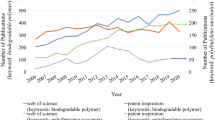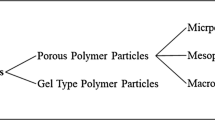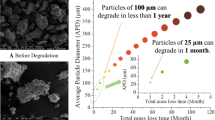Abstract
Suspension polycondensations used to manufacture poly(butylene succinate) (PBS) can be regarded as a type of inverse heterogeneous polymerization technique, as the monomer phase is formed by polar reacting compounds (1,4-butanediol and succinic acid) that are partially soluble in water and require the use of a nonpolar continuous phase in order to form stable suspended droplets. In this context, the main objective of the present study was to investigate the influence of the continuous phase on the kinetic behavior of suspension PBS reactions and the morphological aspects of PBS particles produced through suspension polycondensations. Particularly, renewable soybean oil was used here for the first time as the continuous phase for preparation of PBS microparticles and results were compared to data obtained when paraffin was used as the continuous phase. It is shown that soybean oil can be used successfully as the continuous phase of polycondensations, allowing for production of microparticles with regular spherical morphology and leading to sustainable greener processes, as the constituents of both the continuous and discontinuous phases can be obtained from renewable materials.













Similar content being viewed by others
References
Scott JL, Buchard A (2019) Polymers from plants: biomass fixed carbon dioxide as a resource. Managing global warming. Elsevier, Amsterdam, pp 503–525
Huo B, Gu M, Wang Z (2019) Green or lean? A supply chain approach to sustainable performance. J Clean Prod 216:152–166. https://doi.org/10.1016/j.jclepro.2019.01.141
John G, Nagarajan S, Vemula PK et al (2019) Natural monomers: a mine for functional and sustainable materials—occurrence, chemical modification and polymerization. Prog Polym Sci 92:158–209. https://doi.org/10.1016/j.progpolymsci.2019.02.008
Costa R, Santos L (2017) Delivery systems for cosmetics—from manufacturing to the skin of natural antioxidants. Powder Technol 322:402–416. https://doi.org/10.1016/j.powtec.2017.07.086
Napper IE, Bakir A, Rowland SJ, Thompson RC (2015) Characterisation, quantity and sorptive properties of microplastics extracted from cosmetics. Mar Pollut Bull 99:178–185. https://doi.org/10.1016/j.marpolbul.2015.07.029
Guan J, Chakrapani A, Hansford DJ (2005) Polymer microparticles fabricated by soft lithography. Chem Mater 17:6227–6229
Joye IJ, McClements DJ (2014) Biopolymer-based nanoparticles and microparticles: fabrication, characterization, and application. Curr Opin Colloid Interface Sci 19:417–427. https://doi.org/10.1016/j.cocis.2014.07.002
Jiang W, Gupta RK, Deshpande MC, Schwendeman SP (2005) Biodegradable poly (lactic-co-glycolic acid) microparticles for injectable delivery of vaccine antigens. Adv Drug Deliv 57:391–410. https://doi.org/10.1016/j.addr.2004.09.003
Murillo M, Gamazo C, Irache JM, Gon MM (2002) Polyester microparticles as a vaccine delivery system for brucellosis: influence of the polymer on release. Phagocytosis Toxic 10:211–219. https://doi.org/10.1080/10611860290022642
Obayemi JD, Danyuo Y, Dozie-nwachukwu S et al (2016) PLGA-based microparticles loaded with bacterial-synthesized prodigiosin for anticancer drug release: effects of particle size on drug release kinetics and cell viability. Mater Sci Eng 66:51–65. https://doi.org/10.1016/j.msec.2016.04.071
Machado F, Lima EL, Pinto JC (2007) Uma revisão sobre os processos de polimerização em suspensão. Polímeros 17:166–179. https://doi.org/10.1590/S0104-14282007000200016
Dutra L, Nele M, Pinto JC (2018) A novel approach for the preparation of poly(butylene succinate) microparticles. Macromol Symp 381:1800118. https://doi.org/10.1002/masy.201800118
Dutra L, Souza MN, Pinto JC (2018) Preparation of polymer microparticles through nonaqueous suspension polycondensations. Part II—effects of operating variables on properties of poly(butylene succinate). Macromol React Eng 12:1800039. https://doi.org/10.1002/mren.201800039
da Silva DL, de Souza Belan Coasta T, Lobo VTV et al (2019) Preparation of polymer microparticles through non-aqueous suspension polycondensations: Part III—degradation of PBS microparticles in different aqueous environments. J Polym Environ 27:176–188. https://doi.org/10.1007/s10924-018-1329-x
Brock T, Sherrington DC (1992) Preparation of spherical polybenzimidazole particulates using a non-aqueous suspension methodology. Polymer (Guildf) 33:1773–1777. https://doi.org/10.1016/0032-3861(92)91082-D
Brock T, Sherrington DC, Swindell J (1994) Synthesis and characterisation of porous particulate polyimides. J Mater Chem 4:229. https://doi.org/10.1039/jm9940400229
Ahn J-H, Sherrington DC (1996) Synthesis of functional polyimide beads and use as Mo VI epoxidation catalyst supports. Chem Commun. https://doi.org/10.1039/cc9960000643
Jabbari E, Khakpour M (2000) Preparation of aqueous suspension of porous polyurethane microspheres by suspension polycondensation. Sci Iran 7:102–110. https://doi.org/10.1016/j.jconhyd.2010.08.009
Wang P, Wang K, Zhang J, Luo G (2015) Non-aqueous suspension polycondensation in NMP-CaCl2/paraffin system—a new approach for the preparation of poly(p-phenylene terephthalamide). Chinese J Polym Sci 33:564–575. https://doi.org/10.1007/s10118-015-1607-1
Arshady R (1989) Microspheres and microcapsules: a survey of manufacturing techniques. Part 1: suspension cross-linking. Polym Eng Sci 29:1746–1758. https://doi.org/10.1002/pen.760292404
Bunge (2012) Soya. https://www.soya.com.br/produtos/oleos/oleo-de-soja-soya
ANVISA (2005) Agência Nacional de Vigilância Sanitária. https://bvsms.saude.gov.br/bvs/saudelegis/anvisa/2005/rdc0270_22_09_2005.html
da Silva Dutra L, Nele M, Pinto JC (2020) Preparation of polymer microparticles through non-aqueous suspension polycondensations: Part IV—effect of the continuous phase on the characteristics of final poly(butylene succinate) particles. J Polym Environ
Li W, Ghosh A, Bbosa D et al (2018) Comparative techno-economic, uncertainty and life cycle analysis of lignocellulosic biomass solvent liquefaction and sugar fermentation to ethanol. ACS Sustain Chem Eng 6:16515–16524. https://doi.org/10.1021/acssuschemeng.8b03622
Schwaab M, Pinto JC (2007) Análise de Dados experimentais I Fundamentos de Estatistica e Estimação de Paramêtros. Editora E-papers, Rio de Janeiro
Ebnesajjad S (2006) Surface tension and its measurement. Surface treatment of materials for adhesion bonding. Elsevier, Amsterdam, pp 9–28
December NO (2011) Vegetable oils in food technology. Wiley-Blackwell, Oxford
Bao L, Bian L, Zhao M et al (2014) Synthesis and self-assembly behavior of a biodegradable and sustainable soybean oil-based copolymer nanomicelle. Nanoscale Res Lett 9:1–6. https://doi.org/10.1186/1556-276X-9-391
Khanifah L, Widodo S, Widarto W et al (2018) Characteristics of Paraffin Shielding of Kartini Reactor, Yogyakarta. ASEAN J Sci Technol Dev 35:195–198. https://doi.org/10.29037/ajstd.526
Thakur N, Weatherly CA, Wimalasinghe RM, Armstrong DW (2019) Fabrication of interconnected macroporosity in geopolymers via inverse suspension polymerization. J Am Ceram Soc 102:4405–4409. https://doi.org/10.1111/jace.16437
Jahanzad F, Sajjadi S, Brooks BW (2005) Comparative study of particle size in suspension polymerization and corresponding monomer−water dispersion. Ind Eng Chem Res 44:4112–4119. https://doi.org/10.1021/ie048827f
Brooks B (2010) Suspension polymerization processes. Chem Eng Technol 33:1737–1744. https://doi.org/10.1002/ceat.201000210
Dowding PJ, Vincent B (2000) Suspension polymerisation to form polymer beads. Colloids Surf 161:259–269. https://doi.org/10.1016/S0927-7757(99)00375-1
Azevedo GD, da Silva Pinto JCC (2019) Particle size distributions of P(VAc-co-MMA) beads produced through nonconventional suspension copolymerizations. Powder Technol 355:727–737. https://doi.org/10.1016/j.powtec.2019.07.097
Saien J, Fadaei V (2018) The study of interfacial tension of kerosene-water under influence of CTAB surfactant and different size silica nanoparticles. J Mol Liq 255:439–446. https://doi.org/10.1016/j.molliq.2018.01.120
Rosen MJ, Kunjappu JT (2012) Phenomena surfactants and phenomena. Wiley, Hoboken
Acknowledgements
The authors thank CNPq (Conselho Nacional de Pesquisa e Desenvolvimento Científico e Tecnológico) and FAPERJ (Fundação Carlos Chagas Filho de Amparo à Pesquisa do Estado do Rio de Janeiro) for providing funds and scholarships.
Author information
Authors and Affiliations
Corresponding author
Ethics declarations
Conflict of interest
The authors declare no conflict of interest.
Additional information
Publisher's Note
Springer Nature remains neutral with regard to jurisdictional claims in published maps and institutional affiliations.
Rights and permissions
About this article
Cite this article
da Silva Dutra, L., de Souza, M.N. & Pinto, J.C. Preparation of Polymer Microparticles Through Non-aqueous Suspension Polycondensations: Part IV—Effect of the Continuous Phase on the Characteristics of Final Poly(Butylene Succinate) Particles. J Polym Environ 29, 219–229 (2021). https://doi.org/10.1007/s10924-020-01869-7
Published:
Issue Date:
DOI: https://doi.org/10.1007/s10924-020-01869-7





